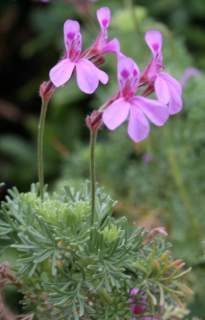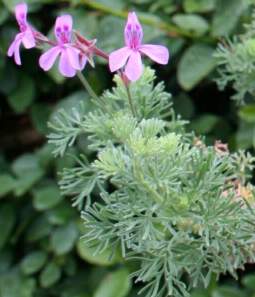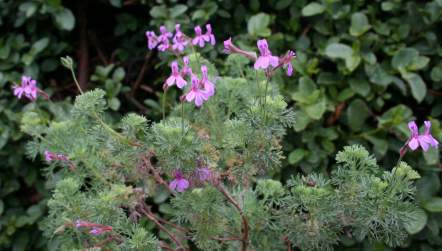Pelargonium abrotanifolium
Pelargonium abrotanifolium (L.f.) Jacq.
Family: Geraniaceae
Common names: southernwood-leaf pelargonium (Eng.); klipmalvabossie, maagbossie, wildemalva (Afr.)
Introduction
This small flowering shrublet with aromatic foliage provides beauty and colour all year round to any arid garden and rockery.

Description
Description
Pelargonium abrotanifolium is an erect, branched shrublet, 500 mm high. The slender, woody branches bear feathery, grey-green leaves, which are pleasantly scented. The inflorescences are unbranched, each peduncle bearing 1-5 flowers. The flowers vary from white, pink to mauve and veined in red or purple. Flowering time: throughout the year.

Conservation Status
Status
Pelargonium abrotanifolium is very common and widespread, and therefore is not threatened.
Distribution and habitat
Distribution description
Pelargonium abrotanifolium has a wide distribution range in the Western Cape, and from Namaqualand to the Eastern Cape as well as the Free State. The shrublet grows in relatively arid habitats where it occurs on rocky outcrops.
Derivation of name and historical aspects
History
The genus Pelargonium derives its name from the resemblance of the shape of the fruit to the beak of a stork, pelargos in Greek. Pelargonium abrotanifolium, ( folium is Latin for leaf), is named after the southernwood, Atermesia abrotanum, as the leaves of this Pelargonium resemble that of the southernwood. According to Moore in Mastalerz (1971), P. abrotanifolium is the only species of the section Ligularia which is in general cultivation in the USA. This species has been grown in the UK since 1791.
The genus Pelargonium belongs to the family Geraniaceae, a large family of 11 genera and 800 species in the subtropical and tropical world. Pelargonium occurs in S, E and NE Africa, Australia, New Zealand, St Helena, Tristan da Cunha, Madagascar and Asia. In southern Africa, 219 of the 270 species occur.
Ecology
Ecology
The seed of Pelargonium is quite interesting: attached to the elliptically shaped seed, is a feathered, tail-like structure that is coiled in a spiral. This tail-like structure allows the seed to bore and secure itself in the soil if twisted around by the wind or by a passing animal.
Uses
Use
There have been no medicinal uses recorded for this plant. The shrublet can be used for a garden display, and is well suited to arid conditions. Pelargonium abrotanifolium is a low-growing shrub, ideally planted between fairly small shrubs that are much taller and with other smaller herbaceous perennials. Providing year round colour, if pruned it will stay compact. The grey-green foliage provides an interesting contrast to normal green foliage in a garden bed.

Growing Pelargonium abrotanifolium
Grow
Pelargonium abrotanifolium is easy to grow from cuttings, which can be taken at any time of the year. Soft, herbaceous stem cuttings should be taken and a rooting hormone for semi-hardwood applied, to stimulate the rooting process. The cuttings should be rooted in a cold frame, in a well-drained medium such as coarse river sand. Rooting will take place within three weeks. Once rooted, the cuttings are potted into a well-drained potting soil. The soil medium is made up of equal parts compost, coarse river sand and loam. Young plants can be fed on a monthly basis with an organic-based liquid or granular fertilizer.
Sow the seeds in a well-drained potting soil at the end of summer. Broadcast the seeds evenly in the seed tray, covering them with a layer of clean, white sand or fine milled pine bark. The depth of sowing is usually one-and-a-half times the size of the seed. Water thoroughly but gently and provide light shade. Germination usually takes place within three weeks. Pelargoniums grown from seed are generally more vigorous than those grown from cuttings. Young seedlings take longer to flower. Once the plant is established in your garden, it requires little maintenance and is fairly waterwise.
References
- Manning, J. 2001. Eastern Cape. South African Wild Flower Guide 2. Botanical Society of South Africa, Cape Town.
- Masterlerz, J. W. 1977. Geraniums. A manual on the culture, diseases, insects, economics, taxonomy and breeding of geraniums. Pennsylvania: Pennsylvania Flower Growers.
- Van der Walt, J.J. 1977. Pelargoniums of southern Africa. Purnell, Cape Town.
Credits
Trevor Adams
Kirstenbosch Botanical Garden
February 2008
Plant Attributes:
Plant Type: Shrub
SA Distribution: Eastern Cape, Free State, Northern Cape, Western Cape
Soil type: Sandy, Loam
Flowering season: Sporadic/All year
PH: Acid, Neutral
Flower colour: Purple, White, Pink
Aspect: Full Sun
Gardening skill: Easy
Special Features:
Horticultural zones











Rate this article
Article well written and informative
Rate this plant
Is this an interesting plant?
Login to add your Comment
Back to topNot registered yet? Click here to register.